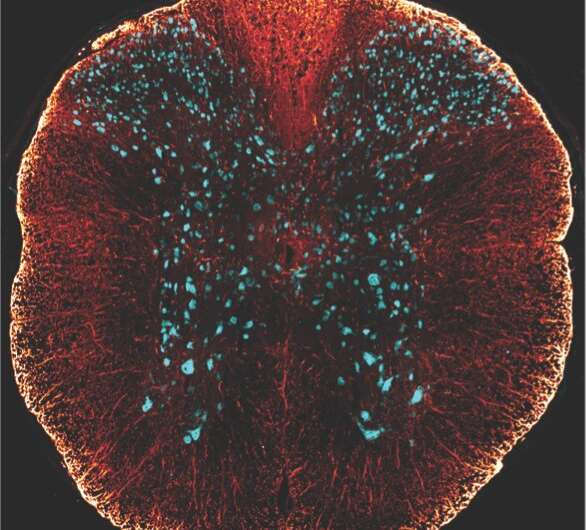'Zombie cells' hold clues to spinal cord injury repair

Mammals have a poor ability to recover after a spinal cord injury, which can result in paralysis. A main reason for this is the formation of a complex scar associated with chronic inflammation that produces a cellular microenvironment blocking tissue repair. Now, a research team led by Leonor Saude, group leader at Instituto de Medicina Molecular Joao Lobo Antunes (iMM; Portugal) and Professor at Faculdade de Medicina da Universidade de Lisboa, have shown that the administration of drugs that target specific cellular components of this scar improve functional recovery after injury. The results now published in the scientific journal Cell Reports set the basis for a new promising therapeutic strategy not only for spinal cord injuries, but potentially for other organs that lack regenerative competence.
This study was performed at iMM with collaboration from researchers at CEDOC NOVA Medical School and was funded by "la Caixa" Foundation—CaixaResearch Call and Fundacao para a Ciencia e a Tecnologia (Portugal).
Leonor Saude and her team have been studying spinal cord injury using two different models: zebrafish, which exhibit spinal injury recovery, and mammals, which show poor recovery. The dense scar that forms at the lesion site has been of particular interest. In mammals, upon spinal cord injury, researchers observed that cells start to accumulate at the lesion periphery. But not any cells: "These cells are known as senescent cells. They have specific features and markers and are what we can call 'zombie cells', where growth and division is interrupted, but where the normal cell death program is not activated," explains Leonor Saude.
"While in zebrafish, the accumulation of these cells at the injury periphery is cleared out over time, in mammals, these cells persist and are important components of the dense scar observed. Because senescent cells have specific molecular markers, there are specific drugs that could be tested in this context," says Diogo Paramos-de-Carvalho, first author of the study. "With the administration of different senolytic drugs, that specifically target these senescent cells, we have observed a progressive decrease of these cells, a decrease in the scar extension and lower levels of inflammation due to a decreased secretion of pro-fibrotic and pro-inflammatory factors. The observed changes at the molecular level underlie the improved locomotor, sensory and bladder functions that we have also found," explains Isaura Martins, also first author of the study.
"Although we are still far from healing spinal cord injuries in humans, we are learning more about the molecular signatures of these lesions and these new promising results can open new therapeutic strategies that can be applied not only to spinal cord injuries but in other conditions that lack regenerative competence," says Leonor Saude.
More information: Targeting senescent cells improves functional recovery after spinal cord injury, Cell Reports (2021). DOI: 10.1016/j.celrep.2021.109334



















